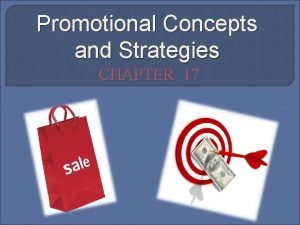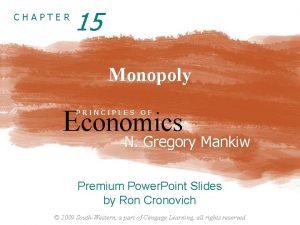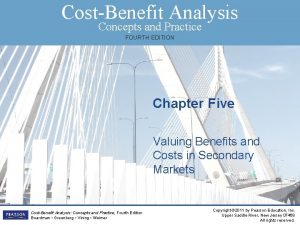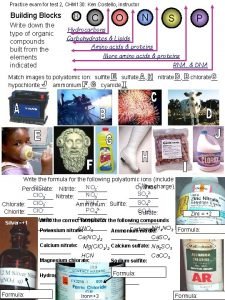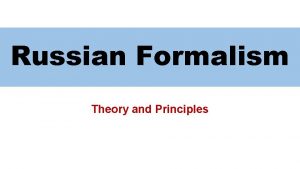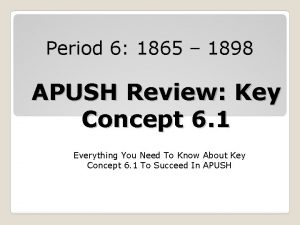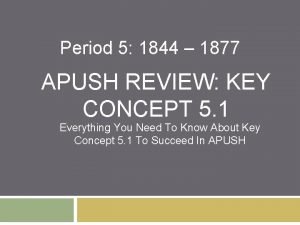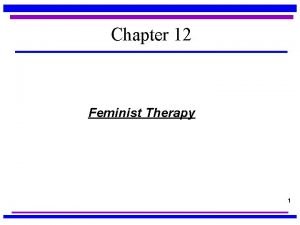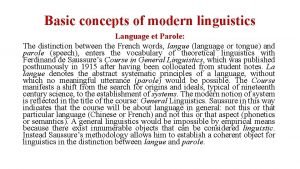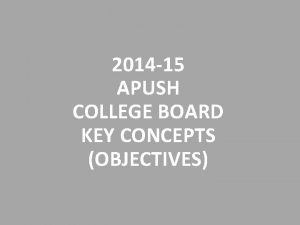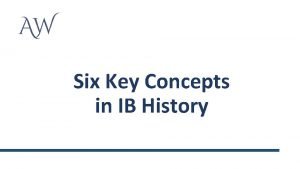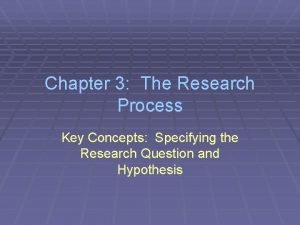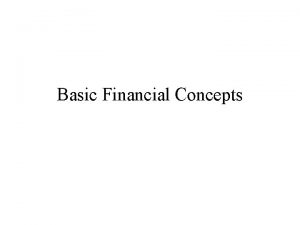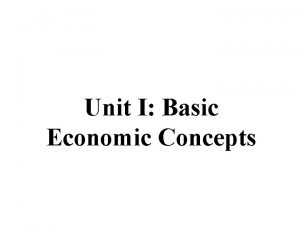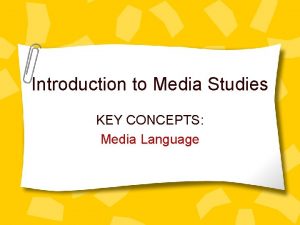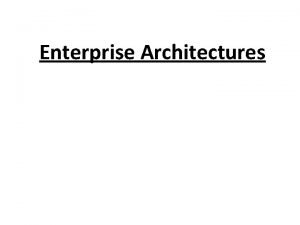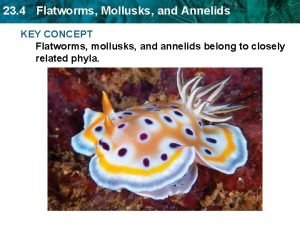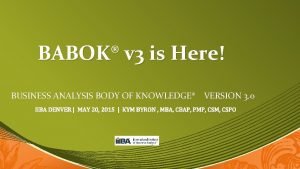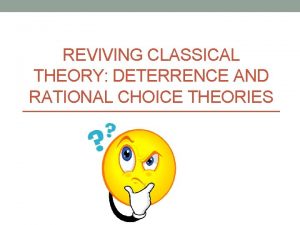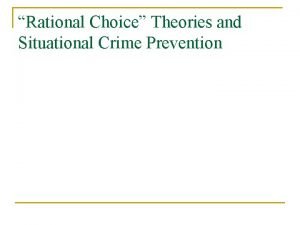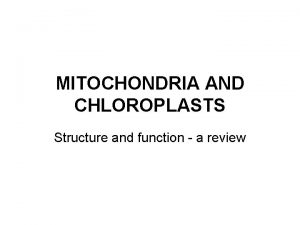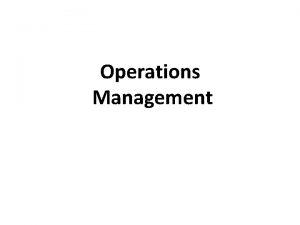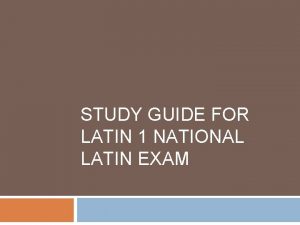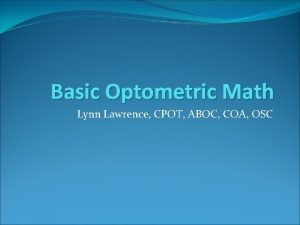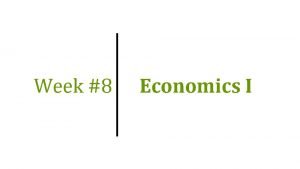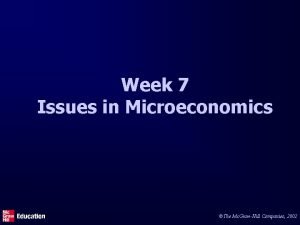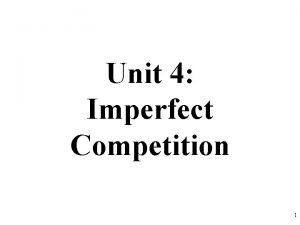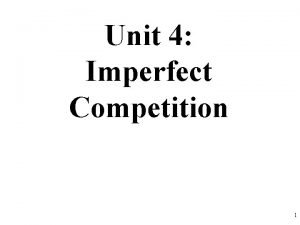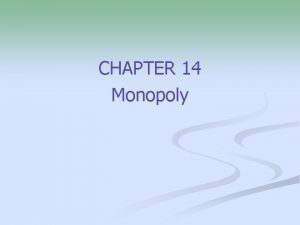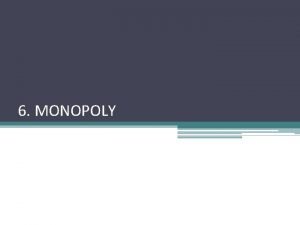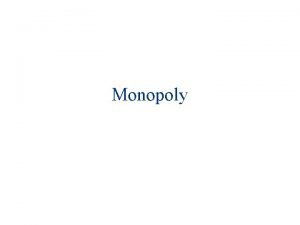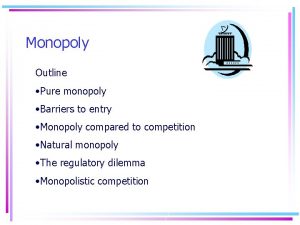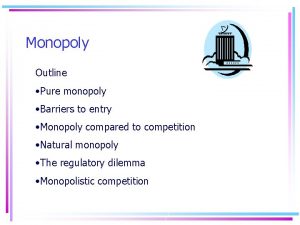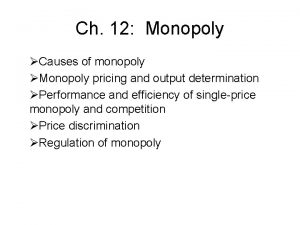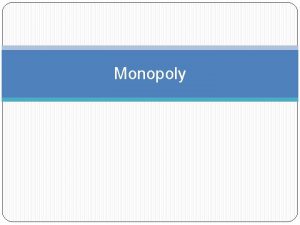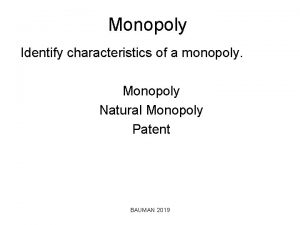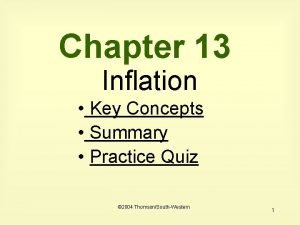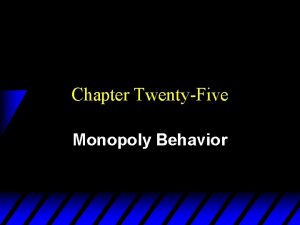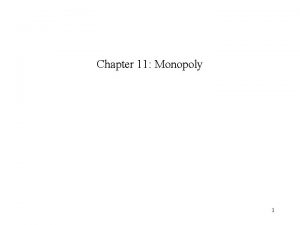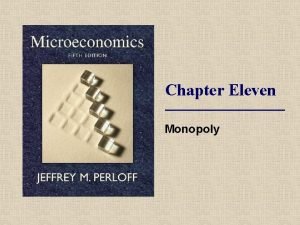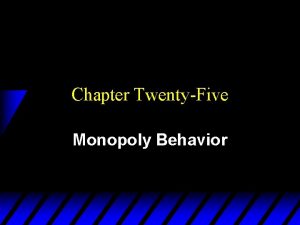Chapter 9 Monopoly Key Concepts Summary Practice Quiz























































- Slides: 55

Chapter 9 Monopoly • Key Concepts • Summary • Practice Quiz • Internet Exercises © 2002 South-Western College Publishing 1

What is a monopoly? • Single seller • Unique product • Impossible entry into the market 2

What are the most common monopolies? Local monopolies are more common real-world approximations of the model than national or world market monopolies 3

What does it mean to have a unique product? There are no close substitutes for the monopolists product 4

What are some examples of impossible entry? • Owner of a vital resource • Legal barriers • Economies of scale 5

What is a natural monopoly? An industry in which the long-run average cost of production declines throughout the entire market 6

What is unique about a natural monopoly? A single firm will produce output at a lower per-unit cost than two or more firms in the industry 7

What is a price maker? A firm that faces a downward-sloping demand curve 8

What is the difference between monopoly and perfect competition? The D and MR curves of the monopolist are downward sloping; in perfect competition they are horizontal 9

What is unique about the demand curve for a monopolist? The monopolist demand curve and the industry demand curve are one in the same 10

Cost per Unit (dollars) 40 35 30 25 20 15 10 5 Minimizing Costs in a Natural Monopoly 5 firms 2 firms 1 firm Quantity of Output 20 40 60 80 100 11

What determines price for a monopolist? Demand 12

Why is MR < P for all but the first unit of output? To sell additional units, the price has to be lowered; this price-cut applies to all units, not just the last unit 13

Dem and l Re ue ven $-25 $-50 $-75 $-100 Price & Marginal Revenue 0 Monopoly a rgin Ma $100 $75 $50 $25 2 4 6 8 10 12 14 16 18 Q 14

Monopoly Total Revenue $400 $300 $200 $100 2 4 6 8 10 12 14 16 18 Q 15

Where does a monopolist produce to maximize profit or minimize losses? MR = MC 16

P $200 $175 $150 $125 $100 $75 $50 $25 MR=MC MC ATC Profit AVC MR D 1 2 3 4 5 6 7 8 9 Q 17

P $200 $175 $150 $125 $100 $75 $50 $25 MC ATC MR=MC Loss AVC MR D 1 2 3 4 5 6 7 8 9 Q 18

Can a monopolist make a profit in the long-run? If the positions of a monopolist’s demand cost curves give it a profit and nothing disturbs these curves, it can make a profit in the long-run 19

What is price discrimination? The practice of a seller charging different prices for the same product not justified by cost differences 20

What is arbitrage? The practice of earning a profit by buying a good at a low price and reselling the good at a higher price 21

Is price discrimination unfair? Many buyers benefit from the discrimination by not being excluded from purchasing the product 22

Is monopoly efficient? A monopolist is inefficient because resources are underallocated to the production of its product 23

P Price Discrimination Market for average students MR=MC T 1 MC MR Q 1 D Q 24

P Monopolist MR=MC Price Discrimination Market for Superior Students MC T 2 MR Q 2 D Q 25

Is perfect competition efficient? A perfectly competitive firm that produces where P = MC achieves an efficient allocation of resources 26

P Perfect Competition MC MR=MC MR, D Pc Qc Q 27

P MR=MC Monopolist MC Pm MR Qm D Q 28

How does monopoly harm consumers? It charges a higher price and produces a lower quantity than would be the case in a perfectly competitive situation 29

P Impact of Monopolizing and Industry MR=MC MC Pm Pc MR Qm Qc D Q 30

What is the case against monopoly? • Higher price • Charges a Price > MC • Long-run economic profit • Alters the distribution of income to favor monopolist 31

Key Concepts 32

Key Concepts • • • What is a monopoly? What is a natural monopoly? What is unique about a natural monopoly? What is a price maker? What is the difference between monopoly and perfect competition? • Why is MR < P for all but the first unit of output? 33

Key Concepts cont. • Where does a monopolist produce to maximize profit or minimize losses? • Can a monopolist make a profit in the longrun? • What is price discrimination? • How does monopoly harm consumers? 34

Summary 35

Monopoly is a single seller facing the entire industry demand curve because it is the industry. The monopolist sells a unique product, and extremely high barriers to entry protect it from competition. 36

Barriers to entry that prevent new firms from entering an industry are (1) ownership of an essential resource, (2) legal barriers, and (3) economies of scale. Government franchises, licenses, patents, and copyrights are the most obvious legal barriers to entry. 37

A natural monopoly arises because of of economies of scale in which the LRAC curve falls as production increases. 38

Without government restrictions, economies of scale allow a single firm to produce at a lower cost than any firm producing a smaller output. Thus, smaller firms leave the industry, new firms fear competing with the monopolist, and the result is that a monopoly emerges naturally. 39

Cost per Unit (dollars) 40 35 30 25 20 15 10 5 Minimizing Costs in a Natural Monopoly 5 firms 2 firms 1 firm Quantity of Output 20 40 60 80 100 40

A price-maker firm faces a downward-sloping demand curve. It therefore searches its demand curve to find the price-output combination that maximizes its profit and minimizes its loss. 41

The marginal revenue and the demand curves are downwardsloping for a monopolist. The marginal revenue curve for a monopolist is below the demand curve, the total revenue curve reaches its maximum where marginal revenue equals zero. 42

Price elasticity of demand corresponds to sections of the marginal revenue curve. When MR is positive, price elasticity of demand is elastic, Ed > 1. When MR is equal to zero, price elasticity of demand is unit elastic, = 1. When MR is negative, price elasticity of demand is inelastic, Ed < 1. 43

The short-run-profit-maximizing monopolist, like the perfectly competitive firm, locates the profitmaximizing price by producing the output where the MR and the MAC curves intersect. If this is less than the AVC curve, the monopolist shuts down to minimize losses. 44

P $200 $175 $150 $125 $100 $75 $50 $25 MR=MC MC ATC Profit AVC MR D 1 2 3 4 5 6 7 8 9 Q 45

P $200 $175 $150 $125 $10 0 $75 $50 $25 MC ATC MR=MC Loss AVC MR D 1 2 3 4 5 6 7 8 9 Q 46

The long-run-profit-maximizing monopolist earns a profit because of barriers to entry. If demand cost conditions prevent the monopolist from earning a profit, it will leave the industry. 47

Price discrimination allows the monopolist to increase profits by charging buyers different prices, rather than a single price. 48

Three conditions are necessary for price discrimination: (1) the demand curve must be downwardsloping, (2) buyers in different markets must have different price elasticities of demand, and (3) buyers must be prevented from reselling the product at a higher price than the purchase price. 49

P Price Discrimination Market for average students MR=MC T 1 MC MR Q 1 D Q 50

P Price Discrimination Monopoli Market for superior students st MR=MC MC T 2 MR Q 2 D Q 51

Monopoly disadvantages are these: (1) A monopolist charges a higher price and produces less output than a perfectly competitive firm, (2) resource allocation is inefficient because the monopolist produces less than if competition existed, (3) monopoly produces higher long-run profits than if competition existed, and (4) monopoly transfers income from consumers to producers to a greater degree than under perfect competition. 52

P Perfect Competition MC MR=MC MR, D Pc Qc Q 53

P MR=MC Monopolist MC Pm MR Qm D Q 54

END 55
 Chapter 17 promotional concepts and strategies answer key
Chapter 17 promotional concepts and strategies answer key Monopoly graph econ
Monopoly graph econ Business key activities
Business key activities Key partners
Key partners Monopoly
Monopoly Module quiz - lan security concepts
Module quiz - lan security concepts Chapter 6 practice test geometry
Chapter 6 practice test geometry Professional nursing practice concepts and perspectives
Professional nursing practice concepts and perspectives Political astuteness in nursing
Political astuteness in nursing Cost-benefit analysis concepts and practice
Cost-benefit analysis concepts and practice Chem 130 final exam
Chem 130 final exam Chapter 10 chemical quantities practice problems answer key
Chapter 10 chemical quantities practice problems answer key Russian formalism شرح
Russian formalism شرح Key concepts examples
Key concepts examples Period 6 key concepts apush
Period 6 key concepts apush Period 5 key concepts apush
Period 5 key concepts apush Period 3 key concepts apush
Period 3 key concepts apush Apush key concepts period 2
Apush key concepts period 2 Key concepts in qualitative research
Key concepts in qualitative research Key concepts of feminist therapy
Key concepts of feminist therapy Reviewing key concepts reproductive barriers
Reviewing key concepts reproductive barriers Parole definition in linguistics
Parole definition in linguistics Apush unit 2 key concepts
Apush unit 2 key concepts Apush college board key concepts
Apush college board key concepts Key concepts of history
Key concepts of history Apush key concepts period 2
Apush key concepts period 2 Apush key concepts period 1
Apush key concepts period 1 Key concepts in research
Key concepts in research Financial management basic concepts
Financial management basic concepts Detente apush
Detente apush Unit 1: basic economic concepts answer key
Unit 1: basic economic concepts answer key 4 key concepts of media
4 key concepts of media Key learning point
Key learning point Adlerian theory key concepts
Adlerian theory key concepts Section 4 flatworms mollusks and annelids
Section 4 flatworms mollusks and annelids Business analysis key concepts
Business analysis key concepts Deterrence and rational choice theory
Deterrence and rational choice theory Rational choice theory key concepts
Rational choice theory key concepts Chloroplast and mitochondria similarities
Chloroplast and mitochondria similarities Key concepts in cultural studies
Key concepts in cultural studies Operation management course outline
Operation management course outline Key concepts of diversity
Key concepts of diversity Inductive and deductive reasoning geometry examples
Inductive and deductive reasoning geometry examples Inductive vs deductive
Inductive vs deductive Representative metal
Representative metal Sid space latin
Sid space latin Particle physics practice quiz
Particle physics practice quiz Transpose glasses rx
Transpose glasses rx Periodic trends practice questions
Periodic trends practice questions Scientific notation online quiz
Scientific notation online quiz Practice assessor feedback examples
Practice assessor feedback examples Welfare loss monopoly
Welfare loss monopoly Social cost of monopoly
Social cost of monopoly Characteristic of monopoly
Characteristic of monopoly Socially optimal quantity graph
Socially optimal quantity graph Advantages and disadvantages of monopolistic competition
Advantages and disadvantages of monopolistic competition
